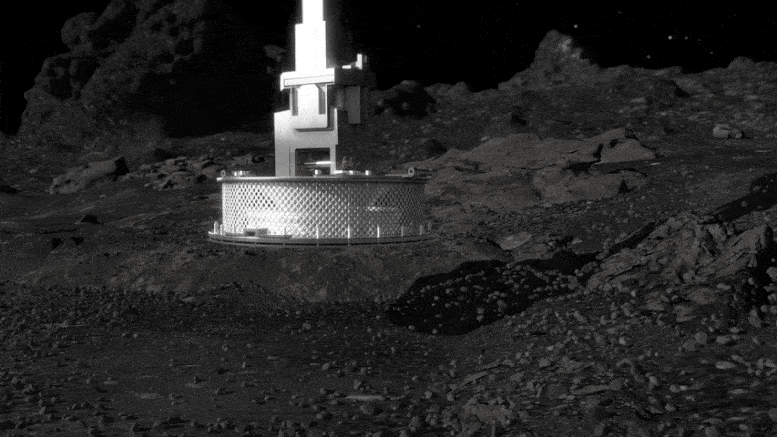This illustration shows NASA’s OSIRIS-REx spacecraft stowing the sample collected from the asteroid Bennu on October 20, 2020. The spaceship uses its TAGSAM (Touch-and-Go Sample Acquisition Mechanism) arm to place the TAGSAM collection head in the sample return capsule (SRC). Photo credit: NASA / University of Arizona, Tucson
NASA‘s OSIRIS-REx The mission is ready to conduct an early stowage of the large sample it collected from the surface of the asteroid Bennu last week on Tuesday, October 27, to protect and return as much sample as possible.
On October 22, the OSIRIS-REx mission team received images showing that the spacecraft’s collection head was overflowing with material collected from Bennu’s surface – well in excess of the two-ounce 60-gram mission requirement – and that some of these particles were present Escape from the collecting head, called TAGSAM (Touch-and-Go Sample Acquisition Mechanism) seemed to be slow.
A Mylar flap on the TAGSAM allows material to easily enter the collection head and should close after the particles have passed through. Larger stones that did not fully pass through the flap into the TAGSAM, however, appear to have trapped this flap, allowing parts of the sample to escape.
Because the first sampling was so successful, NASA’s Science Mission Directorate gave the mission team permission to accelerate the sample stowage in the spacecraft’s Sample Return Capsule (SRC), originally planned for November 2, in order to minimize further sample loss.
The TAGSAM mechanism fired nitrogen gas into Bennu’s surface and created an inverted vacuum to trap small stones and dust in the sampling head. Photo credit: NASA’s Goddard Space Flight Center Conceptual Image Lab
“The abundance of material we have gathered from Bennu made it possible to expedite our stowage decision,” said Dante Lauretta, principal researcher for OSIRIS-REx at the University of Arizona, Tucson. “The team is now working around the clock to speed up traffic jams so we can protect as much of this material as possible for return to Earth.”
In contrast to other spacecraft operations, in which OSIRIS-REx runs through an entire sequence autonomously, the stowage of the sample is gradual and requires the control and input of the team. The team sends the preliminary orders to the spaceship to start the stowage sequence. Once OSIRIS-REx has completed each step in turn, the spaceship will send telemetry and images back to the team on Earth and wait for the team’s confirmation to proceed to the next step.
The signal transmission between Earth and the spacecraft currently takes a little over 18.5 minutes. Each step of the sequence takes into account around 37 minutes of communication transit time. Throughout the process, the mission team will continuously check the alignment of the TAGSAM wrist to ensure that the collection head is properly placed in the SRC. A new imaging sequence has also been added to the process to monitor the material emerging from the collector head and ensure that no particles are interfering with the stagnation process. The mission assumes that the entire stowage process will take several days. In the end, the sample is securely sealed in the SRC for the spacecraft to return to Earth.
“I am proud of the amazing work and success of the OSIRIS-REx team to this point,” said Thomas Zurbuchen, NASA’s Associate Administrator for Science. “This mission is well positioned to bring a historic and substantial sample of an asteroid back to Earth and they have done everything right on an accelerated schedule to protect this precious cargo.”
NASA’s Goddard Space Flight Center in Greenbelt, Maryland, offers the entire mission management, system technology as well as security and mission assurance for OSIRIS-REx. The University of Arizona, Tucson, oversees observation scientific planning and computing for the mission. Lockheed Martin Space in Denver built the spacecraft and offers flight operations. Goddard and KinetX Aerospace in Tempe, Arizona are responsible for navigating the OSIRIS-REx spacecraft. OSIRIS-REx is the third mission in NASA’s New Frontiers Program, administered by NASA’s Marshall Space Flight Center in Huntsville, Alabama for the agency’s Science Mission Directorate in Washington.



